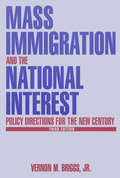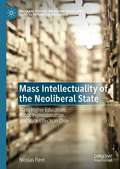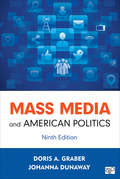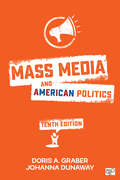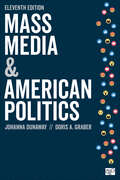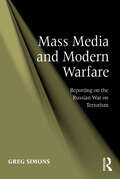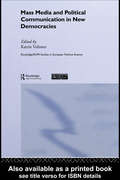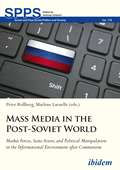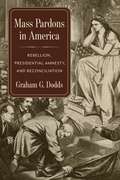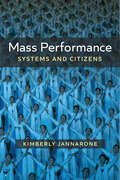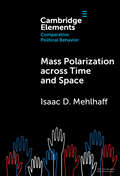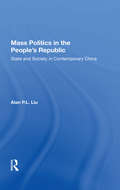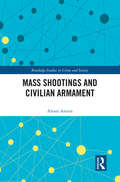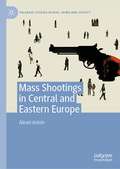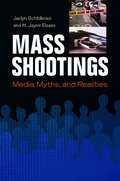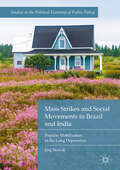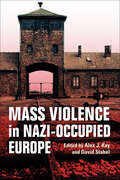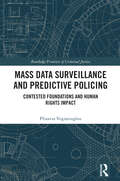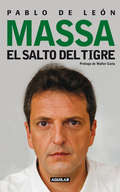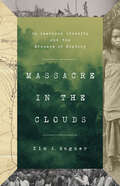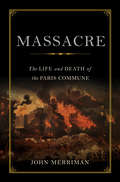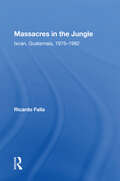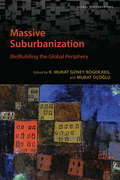- Table View
- List View
Mass Immigration and the National Interest: Policy Directions for the New Century
by Robert O BriggsAs America begins the 21st century there is growing outcry across the land for reform of the nation's chaotic immigration policies. This text shows how immigration patterns are in direct conflict with emerging labour market trends and constitute a serious threat to the jobs of American workers.
Mass Intellectuality of the Neoliberal State: Mass Higher Education, Public Professionalism, and State Effects in Chile (Palgrave Studies on Global Policy and Critical Futures in Education)
by Nicolas FleetThis book addresses the political effects of the massification of higher education and intellectual labor in the neoliberal state. Using the case of Chile, the author argues that public professionalism emerges in the mass university system, producing excesses of knowledge which infuse the state with political purpose at many levels. The emergence of the student movement in 2011, then the major social mobilization against the neoliberal state since the restoration of democracy in 1990, provided a clear manifestation of the politicization and ideological divisions of the mass university system. In conditions of mass intellectuality, public professionals mobilize their political affinities and links with society, eventually affecting the direction of state power, even against neoliberal policy. Through several interviews with academics, public professionals, and other documentary and statistical analyses, the book illustrates the different sites of political socialization and the ideological effectiveness of the emergent mass intellectuality of the neoliberal state.
Mass Media and American Politics
by Doris A. Graber Johanna L. DunawayWith new coauthor Johanna Dunaway, the ninth edition of Doris Graber’s classic book, Mass Media and American Politics, is thoroughly updated to reflect major structural changes that have shaken the world of political news, including new chapters on the impact of the changing media landscape and on negativity, incivility, and bias. Always a balance of comprehensive coverage and cutting-edge theory, this book shows students how the media influence governmental institutions and functions, and in turn how the government shapes the way the media disseminate information. The book’s broad coverage has three focal points: the purpose and structure of media; its impact on the attitudes of ordinary Americans and political elites; and the ways in which the news media cover government and politics.
Mass Media and American Politics
by Doris A. Graber Johanna L. DunawayThis comprehensive, trusted core text on media's impact on attitudes, behavior, elections, politics, and policymaking is known for its readable introduction to the literature and theory of the field. Mass Media and American Politics, Tenth Edition is thoroughly updated to reflect major structural changes that have shaken the world of political news, including the impact of the changing media landscape. It includes timely examples of the significance of these changes pulled from the 2016 election cycle. Written by Doris A. Graber—a scholar who has played an enormous role in establishing and shaping the field of mass media and American politics—and Johanna Dunaway, this book sets the standard.
Mass Media and American Politics
by Doris A. Graber Johanna L. DunawayThis comprehensive, trusted core text on media's impact on attitudes, behavior, elections, politics, and policymaking is known for its readable introduction to the literature and theory of the field. Mass Media and American Politics, Tenth Edition is thoroughly updated to reflect major structural changes that have shaken the world of political news, including the impact of the changing media landscape. It includes timely examples of the significance of these changes pulled from the 2016 election cycle. Written by Doris A. Graber—a scholar who has played an enormous role in establishing and shaping the field of mass media and American politics—and Johanna Dunaway, this book sets the standard.
Mass Media and American Politics
by Doris A. Graber Johanna L. DunawayA comprehensive, trusted core text on media’s impact on attitudes, behavior, elections, politics, and policymaking, Mass Media and American Politics is known for its readable introduction to the literature and theory of the field, and for staying current with each new edition on issues of new and social media, media ownership, the regulatory environment, infotainment, and war-time reporting. Written by the late Doris Graber--a scholar who has played an enormous role in establishing and shaping the field of mass media and American politics--and now lead by Johanna Dunaway, this book has set the standard for the course. New to this edition: Extensive coverage of political misinformation - the role changing communication technologies and mass media more generally are playing in its consumption and dissemination, as well as how the press is handling and should handle reporting on political misinformation, especially as it pertains to the presidency, elections, and crises like Covid-19. Updated coverage of the role social media and other popular digital platforms are playing (or not playing) in the effort to stop the spread of mis- and dis-information on their platforms, with special attention to both foreign and domestic efforts to use these platforms to incite violence, cause confusion about, and/or encourage distrust in, democratic institutions. Expanded treatment of rising affective, social, and ideological polarization in politics, with a special focus on whether and how mass media are contributing to these forms of polarization. New updates on causes and consequences of expanding news deserts, declining local news, and rampant growth of hedge-fund media ownership. Up to date coverage of what researchers are learning about the implications of growth in digital, social and mobile media use. What does it mean for attention to news and politics?
Mass Media and American Politics
by Doris A. Graber Johanna L. DunawayA comprehensive, trusted core text on media’s impact on attitudes, behavior, elections, politics, and policymaking, Mass Media and American Politics is known for its readable introduction to the literature and theory of the field, and for staying current with each new edition on issues of new and social media, media ownership, the regulatory environment, infotainment, and war-time reporting. Written by the late Doris Graber--a scholar who has played an enormous role in establishing and shaping the field of mass media and American politics--and now lead by Johanna Dunaway, this book has set the standard for the course. New to this edition: Extensive coverage of political misinformation - the role changing communication technologies and mass media more generally are playing in its consumption and dissemination, as well as how the press is handling and should handle reporting on political misinformation, especially as it pertains to the presidency, elections, and crises like Covid-19. Updated coverage of the role social media and other popular digital platforms are playing (or not playing) in the effort to stop the spread of mis- and dis-information on their platforms, with special attention to both foreign and domestic efforts to use these platforms to incite violence, cause confusion about, and/or encourage distrust in, democratic institutions. Expanded treatment of rising affective, social, and ideological polarization in politics, with a special focus on whether and how mass media are contributing to these forms of polarization. New updates on causes and consequences of expanding news deserts, declining local news, and rampant growth of hedge-fund media ownership. Up to date coverage of what researchers are learning about the implications of growth in digital, social and mobile media use. What does it mean for attention to news and politics?
Mass Media and Modern Warfare: Reporting on the Russian War on Terrorism
by Greg SimonsMass media are essential to democratic society; in contrast, the War on Terror has been interpreted as an assault on democracy and freedom by Islamic fundamentalists. The building and maintenance of public support is essential in modern warfare due to the increasing politicization of warfare, where losses and gains are measured in political rather than military terms. And if progress cannot be demonstrated during a war, then by default one is assumed to be losing. Greg Simons tackles the complicated yet essential role of mass media in society. Taking the Global War on Terror as a prime example, the author adopts a multidisciplinary approach to analyze the various facets of war and the role of the media within it. Assessing in particular the Russian fight against terrorism, this book provides a broader perspective and understanding of contemporary struggles.
Mass Media and Political Communication in New Democracies (Routledge/ECPR Studies in European Political Science #Vol. 42)
by Katrin VoltmerThis book examines how political communication and the mass media have played a central role in the consolidation of emerging democracies around the world. Covering a broad range of political and cultural contexts, including Eastern and Southern Europe, Latin America, Asia and Africa, this new volume investigates the problems and conflicts arising in the process of establishing an independent media and competitive politics in post-autocratic societies. Considering the changing dynamic in the relationship between political actors, the media and their audience, the authors of this volume address the following issues: changing journalistic role perceptions and journalistic quality the reasons and consequences of persisting instrumentalization of the media by political actors the role of the media in election campaigns the way in which the citizens interpret political messages and the extent to which the media influence political attitudes and electoral behaviour the role of the Internet in building a democratic public sphere This book will be of great interest to all those studying and researching democracy and democratization, comparative politics, political communication, journalism, media and the Internet.
Mass Media in the Post-Soviet World: Market Forces, State Actors, and Political Manipulation in the Informational Environment after Communism (Soviet and Post-Soviet Politics and Society #178)
by Marlene Laruelle Peter RollbergThis collection covers the major trends of the media environment of the post-Communist world and their recent development, with special focus on Russia and the post-Soviet space. The term "media environment" covers not just traditional print and electronic media, but new media as well, and ranges from the political to entertainment and various artistic spheres. What role do market forces play in the process of media democratization, and how do state structures regulate, suppress, or use capitalism toward their own gain? What degree of informational pluralism has been achieved in the newly independent republics? What are the prospects for transparency and the participation of civil society in Russian and Eurasian media? To what degree do trends in post-Communist media reflect global trends? Is there a worldwide convergence with regard to both media formats and political messaging?Western observers usually pay their keenest attention to the role of media in Russia and Eurasia during national elections. While this is a valid focus, the present volume, with contributions by Luca Anceschi, Jonathan Becker, Lee B. Becker, Michael Cecire, Marta Dyczok, Nicola Ying Fry, Navbahor Imamova, Azamat Junisbai, Barbara Junisbai, Kornely Kakachia, Maria Lipman, Oleg Manaev, Marintha Miles, Olena Nikolayenko, Sarah Oates, Tamara Pataraia, Elisabeth Schimpfossl, Abdulfattoh Shafiev, Jack Snyder, Tudor Vlad, and Ilya Yablokov, aims at understanding the deeper overall media philosophies that characterize post-Soviet media systems and environments, and the type of identity formation that they are promoting.
Mass Pardons in America: Rebellion, Presidential Amnesty, and Reconciliation
by Graham DoddsAgain and again in the nation’s history, presidents of the United States have faced the dramatic challenge of domestic insurrection and sought ways to reconcile with the rebels afterward. This book is the first comprehensive study of how presidential mass pardons have helped put such conflicts to rest. Graham G. Dodds examines when and why presidents have issued mass pardons and amnesties to deal with domestic rebellion and attempt to reunite the country. He analyzes how presidents have used both deeds and words—proclamations of mass pardons and persuasive rhetoric—in order to foster political reconciliation.The book features in-depth case studies of the key instances of mass pardons in U.S. history, beginning with George Washington’s and John Adams’s pardoning participants in armed insurrections in Pennsylvania in the 1790s. In the nineteenth century, James Buchanan, Benjamin Harrison, and Grover Cleveland issued pardons to Mormon insurrectionists and polygamists, and Abraham Lincoln and Andrew Johnson pardoned Confederates both during and after the Civil War. Most recently, Dodds considers Gerald Ford’s clemency and Jimmy Carter’s amnesty of Vietnam War resisters.Beyond exploring these events, Mass Pardons in America offers new perspectives on the president’s pardon power, unilateral presidential actions, and presidential rhetoric more broadly. Its implications span fields including political history, presidential studies, and legal history.
Mass Performance: Systems and Citizens
by Kimberly JannaroneMass Performance: Systems and Citizens examines mass performance systems from the first major festival of the French Revolution through the democratic and socialist movements of the nationalizing nineteenth and twentieth centuries in Europe, to totalitarian communist and socialist regimes in the twentieth century, ending with contemporary North Korea. While other scholars have studied specific mass performances, this study synthesizes the phenomenon across centuries and countries, focusing on its systemization. Modern nations defining or redefining their identities not only organized mass performances, but also planned to make those performances a permanent component of nationhood. Kimberly Jannarone reveals that mass performance systems, including synchronized gymnastics to choreographed rallies, encapsulate ideals and debates within emerging nations about the relationship of citizens to each other and to their leaders, playing a generative and reflective role in the culture and politics of the modern era. Mass Performance analyzes the specifics of performance choreography and design, the organizational planning and thinking behind the systems, the material circumstances of each system’s emergence, and the broader intellectual milieu in which they developed. Although not a comprehensive study of such events, Jannarone’s analysis of the selected mass performance systems yields new theoretical perspectives on these phenomena, a central focus of her study being how political leaders find ways to create a physically coordinated mass body politic, even during times of hardship and war. By interpreting and historicizing mass assemblies of bodies, this study analyzes the choreographies and organizations that brought thousands of people together as an ensemble and kept them together in meaning-making motion.
Mass Polarization across Time and Space (Elements in Comparative Political Behavior)
by Isaac D. MehlhaffMass polarization is one of the defining features of politics in the twenty-first century, but efforts to understand its causes and effects are often hindered by empirical challenges related to measurement and data availability. To address these challenges and provide a common standard of analysis for researchers, this Element presents the Polarization in Comparative Attitudes Project (PolarCAP). PolarCAP clearly defines polarization as a property of group relations and uses a Bayesian measurement model to estimate smooth panels of ideological and affective polarization across ninety-two countries and forty-nine years. The author uses these data to provide a descriptive account of mass polarization across time and space. They further show how PolarCAP facilitates substantive inference by applying it to three sets of variables often hypothesized as causes or consequences of polarization: institutional design, economic crisis, and democracy. Open-source software makes PolarCAP easily accessible to scholars and practitioners.
Mass Politics In The People's Republic: State And Society In Contemporary China
by Alan P.L. LiuExploring the crucial link between state and society in the People's Republic of China (PRC), this book analyzes the interaction between the Chinese Communist Party and the country's major social groups. It explores how public opinion contributes to a mass political culture in China.
Mass Shootings and Civilian Armament (Routledge Studies in Crime and Society)
by Alexei AnisinMass Shootings and Civilian Armament provides the first comprehensive multi-methodological analysis of the relationship between mass shootings and firearm purchases (as proxied by background checks) in the US on national level data from 1999-2020. Since 1994, the number of civilian-owned firearms in the US has doubled to around 398 million while the population only grew by 70 million. On average, mass shootings have occurred once every two weeks over the last decade which is a major factor behind why social scientists have started to ask whether mass shootings play a causative role in civilian decisions to purchase guns. Utilizing a multi-methodological approach featuring quantitative, comparative/configurational, and qualitative methods, this book puts forward a theoretical framework and argues that mass shootings do increase civilian armament, but that this repetitious effect is historically contingent, asymmetric, and non-linear. Particular types of mass shootings are hypothesized to have driven and continue to bring about increased levels of civilian firearm purchases through different pathways and combinations of variables – those that feature high fatality counts; arise in areas of cultural importance, are ideologically motivated. First, inquiry into background check data (1999-2020) and data on 213 mass shootings and attempted mass shootings is carried out to find out which shootings (as well as controls) are significantly correlated with background check increases. Second, the findings are utilized in a theoretically driven comparative configurational assessment to test if the noted theoretical pathways are associated with the outcome of increased post-shooting armament. Third, the empirical analyses are complimented by three case studies – the 2011 Gabrielle Giffords shooting (illustrative of the high fatality pathway), the 2012 Colorado movie theater shooting (illustrative of the cultural pathway), and the 2015 Charleston Church shooting (illustrative of the ideologically driven pathway). Interdisciplinary in nature, Mass Shootings and Civilian Armament will not only be of great interest to scholars of Criminology, but will also speak to sociologists, economists, public policy scholars, political scientists, historians, as well as cultural studies and American studies scholars.
Mass Shootings in Central and Eastern Europe (Palgrave Studies in Risk, Crime and Society)
by Alexei AnisinThis book examines mass shootings and attempted shootings that occurred across 16 countries in Central and Eastern Europe, known as post-communist states. This region of the world has been described by social scientists as possessing specific social, cultural, and political characteristics which may mean that mass shootings in this part of the world are driven by distinct causal factors in comparison to those in North America and elsewhere. This book explores trends and patterns that underpin cases in this under-explored region and tests whether Cumulative Strain Theory can account for mass shooting occurrences. It uses in-depth qualitative analysis to examine select case studies in one chapter, followed by a chapter which uses quantitative methods to identify trends across a wider set of cases and to test the theoretically-driven hypotheses. This data is then compared with data in the US. This book draws on a wide range of media, forensic and court reports and provides methodological insights and discussions of future trends including the potential incidental increase of mass shootings in these regions. It also engages in recent public policy debates pertaining to firearm ownership and regulation.
Mass Shootings: Media, Myths, and Realities (Crime, Media, and Popular Culture)
by Jaclyn Schildkraut H. Jaymi ElsassWhen a mass shooting happens, the news media is flooded with headlines and breaking information about the shooters, victims, and acts themselves. What is notably absent in the news reporting are any concrete details that serve to inform news consumers how prevalent these mass shootings really are (or are not, when considering crime statistics as a whole), what legitimate causes for concern are, and how likely an individual is to be involved in such an incident. Instead, these events often are used as catalysts for conversations about larger issues such as gun control and mental health care reform.
Mass Strikes and Social Movements in Brazil and India: Popular Mobilisation in the Long Depression (Studies in the Political Economy of Public Policy)
by Jörg Nowak“Jörg Nowak has written an ambitious, wide-ranging and very important book. Based on extensive empirical research in Brazil and India and a thorough analysis of the secondary literature, Nowak reveals that numerous labour conflicts develop in the absence of trade unions, but with the support of kinship networks, local communities, social movements and other types of associations. This impressive work may well become a major building block for a new interpretation of global workers’ struggles.”—Marcel van der Linden, International Institute of Social History, The Netherlands“Nowak’s book meticulously details the trajectory of strikes and its resultant new forms of organisations in India and Brazil. The central focus of this analytically rich and thought provoking book is to search for a new political alternative model of organising workers. A very good deed indeed!”—Nandita Mondal, Tata Institute of Social Sciences, India“Jörg Nowak analyses with critical sense forms of popular organization that often remain invisible. It is an indispensable book for all those who are looking for more effective analytical resources to better understand the present situation and the future promises of the workers’ movements.”—Roberto Véras de Oliveira, Federal University of Paraíba, Brazil“In this timely and important study, Nowak convincingly challenges the dominant Eurocentric approach to labour conflict and calls for a new theory of strikes. He stresses the need to engage in a wider perspective that includes social reproduction, neighbourhood mobilisations, and the specific traditions of struggles in the Global South.”—Edward Webster, University of Witwatersrand, South AfricaThis book explores new forms of popular organisation that emerged from strikes in India and Brazil between 2011 and 2014. Based on four case studies, the author traces the alliances and relations that strikers developed during their mobilisations with other popular actors such as students, indigenous peoples, and people displaced by dam projects. The study locates the mass strikes in Brazil’s construction industry and India’s automobile industry in a global conjuncture of protest movements, and develops a new theory of strikes that can take account of the manifold ways in which labour unrest is embedded in local communities and regional networks.
Mass Violence in Nazi-Occupied Europe
by David Stahel Alex J. KayThis scholarly anthology explores the violence perpetrated by Nazi Germany, shedding new light on its staggering scale and scope.Mass Violence in Nazi-Occupied Europe argues for a more comprehensive understanding of what constitutes Nazi violence and who was affected by this violence. The works gathered consider sexual violence, food depravation, and forced labor as aspects of Nazi aggression.Contributors focus in particular on the Holocaust, the persecution of the Sinti and Roma, the eradication of “useless eaters” (psychiatric patients and Soviet prisoners of war), and the crimes of the Wehrmacht. The collection concludes with a consideration of memorialization and a comparison of Soviet and Nazi mass crimes.
Mass data surveillance and predictive policing: Contested Foundations and Human Rights Impact (Routledge Frontiers of Criminal Justice)
by Plixavra VogiatzoglouThis book critically assesses legal frameworks involving the bulk processing of personal data, initially collected by the private sector, to predict and prevent crime through advanced profiling technologies. In the European Union (EU), mass data surveillance currently engages three sectors: electronic communications (under the e-Privacy Directive), air travelling (under the Passenger Name Records Directive), and finance (under the Anti-Money Laundering Directive), and increasingly intersects with the deployment of predictive policing techniques. The book questions the legitimacy and impact of these frameworks in light of the EU’s powers to provide security while safeguarding fundamental rights, particularly privacy, data protection, e-ective remedy, fair trial, and presumption of innocence.Focusing on the security shift towards forestalling crime before it occurs, the book identifies its distinct characteristics, such as the blurred lines between the public and private sector actors, and interrogates whether the legal bases and traditional theories on security can account for it. The book further explores the challenges these pre-crime practices pose, including their questionable e-ectiveness and the ambiguous application of human rights safeguards in situations where no crime has been committed, yet individuals face consequences as a result of deploying predictive analytics on mass amounts of commercially collected personal data. In examining the interference with several fundamental rights, the book also highlights aspects neglected by the jurisprudence of the Court of Justice of the European Union and the European Court of Human Rights, such as the expansive nature and the collective and cumulative e-ects of these frameworks.
Massa. El salto del Tigre
by Pablo De León¿Quién es Sergio Massa? ¿Cómo ha llegado a emerger como figura en el mapa político nacional este joven intendente de poco más de cuarenta años? "Sobre una contradicción -un oxímoron, en retórica- Sergio Massa construyó en unas pocas semanas un proyecto que ha puesto en riesgo por primera vez la hegemonía de una década de kirchnerismo. Para este desafío le alcanzó apenas con plantear una incerteza en una época de absolutos", afirma Walter Curia en el prólogo a este libro. El periodista Pablo de León investigó y siguió de cerca al personaje para develarnos su origen y sus conexiones, su intimidad y su exposición pública y política, analizando sus vínculos con el poder. «Este libro de Pablo de León es el primer intento desde el periodismo por despejar las incógnitas del fenómeno Sergio Massa, el peronista que liderando una oposición blanda y con una retórica conciliadora se trepó al escenario político para disputar el poder a Cristina Kirchner.»Walter Curia
Massacre in the Clouds: An American Atrocity and the Erasure of History
by Kim A. WagnerIn this &“forensic, unflinching, devastating work of historical recovery&” (Sathnam Sanghera), Bud Dajo—an American atrocity bigger than Wounded Knee or My Lai, yet today largely forgotten—is revealed, thanks to the rediscovery of a single photograph. In March 1906, American soldiers on the island of Jolo in the southern Philippines surrounded and killed 1000 local men, women, and children, known as Moros, on top of an extinct volcano. The so-called &‘Battle of Bud Dajo&’ was hailed as a triumph over an implacable band of dangerous savages, a &“brilliant feat of arms&” according to President Theodore Roosevelt. Some contemporaries, including W.E.B. Du Bois and Mark Twain, saw the massacre for what it was, but they were the exception and the U.S. military authorities successfully managed to bury the story. Despite the fact that the slaughter of Moros had been captured on camera, the memory of the massacre soon disappeared from the historical record. In Massacre in the Clouds, Kim A. Wagner meticulously recovers the history of a forgotten atrocity and the remarkable photograph that exposed its grim logic. His vivid, unsparing account of the massacre—which claimed hundreds more lives than Wounded Knee and My Lai combined—reveals the extent to which practices of colonial warfare and violence, derived from European imperialism, were fully embraced by Americans with catastrophic results.
Massacre: The Life and Death of the Paris Commune
by John MerrimanThe Paris Commune lasted for only 64 days in 1871, but during that short time it gave rise to some of the grandest political dreams of the nineteenth century—before culminating in horrific violence. Following the disastrous French defeat in the Franco-Prussian War, hungry and politically disenchanted Parisians took up arms against their government in the name of a more just society. They expelled loyalists and soldiers and erected barricades in the streets. In Massacre, John Merriman introduces a cast of inimitable Communards—from les pétroleuses (female incendiaries) to the painter Gustave Courbet—whose idealism fueled a revolution. And he vividly recreates the Commune’s chaotic and bloody end when 30,000 troops stormed the city, burning half of Paris and executing captured Communards en masse. A stirring evocation of the spring when Paris was ablaze with cannon fire and its citizens were their own masters, Massacre reveals how the indomitable spirit of the Commune shook the very foundations of Europe.
Massacres In The Jungle: Ixcan, Guatemala, 1975-1982
by Ricardo FallaBetween 1975 and 1982 the Guatemalan military systematically and sadistically punished the campesino population for the activities of guerrilleros in their region. This account by Ricardo Falla, an anthropologist and Jesuit priest who is himself a Guatemalan exile, shows how the victims and their communities were destroyed and provides a detailed record of assassinations and disappearances. The book also bears witness to the work of Catholic priests who are dedicating themselves to improving the lives of the peoples of Central America.
Massive Suburbanization: (Re)Building the Global Periphery (Global Suburbanisms)
by Roger Keil K. Murat Guney Murat UcogluProviding a systematic overview of large-scale housing projects, Massive Suburbanization investigates the building and rebuilding of urban peripheries on a global scale. Offering a universal inter-referencing point for research on the dynamics of "massive suburbia," this book builds a new discussion pertaining to the problems of the urban periphery, urbanization, and the neoliberal production of space. Conceptual and empirical chapters revisit the classic cases of large-scale suburban building in Canada, the former Czechoslovakia, France, Germany, and the United States and examine the new peripheral estates in China, Egypt, Israel, Morocco, the Philippines, South Africa, and Turkey. The contributors examine a broad variety of cases that speak to the building or redevelopment of large-scale peripheral housing estates, tower neighbourhoods, Grands Ensembles, Groβwohnsiedlungen, and Toplu Konut. Concerned with state and corporate policy for building suburban estates, Massive Suburbanization confronts the politics surrounding local inhabitants and their "right to the suburb."
